Related Research Articles

In the mathematical field of graph theory, a bipartite graph is a graph whose vertices can be divided into two disjoint and independent sets and , that is, every edge connects a vertex in to one in . Vertex sets and are usually called the parts of the graph. Equivalently, a bipartite graph is a graph that does not contain any odd-length cycles.
This is a glossary of graph theory. Graph theory is the study of graphs, systems of nodes or vertices connected in pairs by lines or edges.

In graph theory, a perfect graph is a graph in which the chromatic number equals the size of the maximum clique, both in the graph itself and in every induced subgraph. In all graphs, the chromatic number is greater than or equal to the size of the maximum clique, but they can be far apart. A graph is perfect when these numbers are equal, and remain equal after the deletion of arbitrary subsets of vertices.

In graph theory, the perfect graph theorem of László Lovász states that an undirected graph is perfect if and only if its complement graph is also perfect. This result had been conjectured by Berge, and it is sometimes called the weak perfect graph theorem to distinguish it from the strong perfect graph theorem characterizing perfect graphs by their forbidden induced subgraphs.
In the mathematical discipline of graph theory, the line graph of an undirected graph G is another graph L(G) that represents the adjacencies between edges of G. L(G) is constructed in the following way: for each edge in G, make a vertex in L(G); for every two edges in G that have a vertex in common, make an edge between their corresponding vertices in L(G).

In graph theory, a proper edge coloring of a graph is an assignment of "colors" to the edges of the graph so that no two incident edges have the same color. For example, the figure to the right shows an edge coloring of a graph by the colors red, blue, and green. Edge colorings are one of several different types of graph coloring. The edge-coloring problem asks whether it is possible to color the edges of a given graph using at most k different colors, for a given value of k, or with the fewest possible colors. The minimum required number of colors for the edges of a given graph is called the chromatic index of the graph. For example, the edges of the graph in the illustration can be colored by three colors but cannot be colored by two colors, so the graph shown has chromatic index three.

In graph theory, a Meyniel graph is a graph in which every odd cycle of length five or more has at least two chords. The chords may be uncrossed or they may cross each other, as long as there are at least two of them.
In mathematics, in the areas of order theory and combinatorics, Dilworth's theorem characterizes the width of any finite partially ordered set in terms of a partition of the order into a minimum number of chains. It is named for the mathematician Robert P. Dilworth (1950).

Paul D. Seymour is a British mathematician known for his work in discrete mathematics, especially graph theory. He was responsible for important progress on regular matroids and totally unimodular matrices, the four colour theorem, linkless embeddings, graph minors and structure, the perfect graph conjecture, the Hadwiger conjecture, claw-free graphs, χ-boundedness, and the Erdős–Hajnal conjecture. Many of his recent papers are available from his website.
In the mathematical field of graph theory, an induced subgraph of a graph is another graph, formed from a subset of the vertices of the graph and all of the edges connecting pairs of vertices in that subset.

In graph theory, a factor of a graph G is a spanning subgraph, i.e., a subgraph that has the same vertex set as G. A k-factor of a graph is a spanning k-regular subgraph, and a k-factorization partitions the edges of the graph into disjoint k-factors. A graph G is said to be k-factorable if it admits a k-factorization. In particular, a 1-factor is a perfect matching, and a 1-factorization of a k-regular graph is a proper edge coloring with k colors. A 2-factor is a collection of cycles that spans all vertices of the graph.

In graph theory, a mathematical discipline, a factor-critical graph is a graph with n vertices in which every subgraph of n − 1 vertices has a perfect matching.
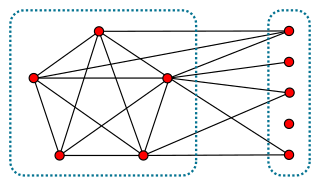
In graph theory, a branch of mathematics, a split graph is a graph in which the vertices can be partitioned into a clique and an independent set. Split graphs were first studied by Földes and Hammer, and independently introduced by Tyshkevich and Chernyak (1979), where they called these graphs "polar graphs".
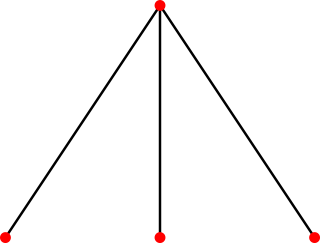
In graph theory, an area of mathematics, a claw-free graph is a graph that does not have a claw as an induced subgraph.
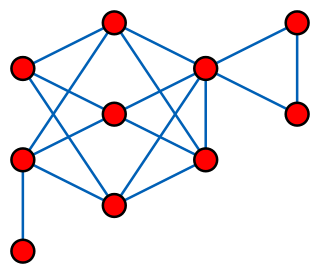
In graph theory, a branch of discrete mathematics, a distance-hereditary graph is a graph in which the distances in any connected induced subgraph are the same as they are in the original graph. Thus, any induced subgraph inherits the distances of the larger graph.

Maria Chudnovsky is an Israeli-American mathematician working on graph theory and combinatorial optimization. She is a 2012 MacArthur Fellow.
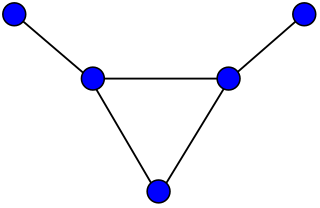
In the mathematical field of graph theory, the bull graph is a planar undirected graph with 5 vertices and 5 edges, in the form of a triangle with two disjoint pendant edges.
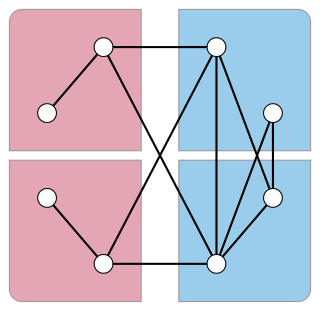
In graph theory, a skew partition of a graph is a partition of its vertices into two subsets, such that the induced subgraph formed by one of the two subsets is disconnected and the induced subgraph formed by the other subset is the complement of a disconnected graph. Skew partitions play an important role in the theory of perfect graphs.

In the mathematical discipline of graph theory, Petersen's theorem, named after Julius Petersen, is one of the earliest results in graph theory and can be stated as follows:
Petersen's Theorem. Every cubic, bridgeless graph contains a perfect matching.
In graph theory, a balanced hypergraph is a hypergraph that has several properties analogous to that of a bipartite graph.
References
- Berge, Claude (1961), "Färbung von Graphen, deren sämtliche bzw. deren ungerade Kreise starr sind", Wiss. Z. Martin-Luther-Univ. Halle-Wittenberg Math.-Natur. Reihe, 10: 114.
- Berge, Claude (1963), "Perfect graphs", Six Papers on Graph Theory, Calcutta: Indian Statistical Institute, pp. 1–21.
- Chudnovsky, Maria (2006), "Berge trigraphs", Journal of Graph Theory, 53 (1): 1–55, doi:10.1002/jgt.20165, MR 2245543 .
- Chudnovsky, Maria; Robertson, Neil; Seymour, Paul; Thomas, Robin (2006), "The strong perfect graph theorem", Annals of Mathematics , 164 (1): 51–229, arXiv: math/0212070 , doi:10.4007/annals.2006.164.51, MR 2233847 .
- Chudnovsky, Maria; Robertson, Neil; Seymour, Paul; Thomas, Robin (2003), "Progress on perfect graphs", Mathematical Programming, Series B., 97 (1–2): 405–422, CiteSeerX 10.1.1.137.3013 , doi:10.1007/s10107-003-0449-8, MR 2004404 .
- Chvátal, Václav (1985), "Star-cutsets and perfect graphs", Journal of Combinatorial Theory, Series B, 39 (3): 189–199, doi:10.1016/0095-8956(85)90049-8, MR 0815391 .
- Chvátal, Václav; Sbihi, Najiba (1987), "Bull-free Berge graphs are perfect", Graphs and Combinatorics , 3 (2): 127–139, doi:10.1007/BF01788536, MR 0932129 .
- Cornuéjols, Gérard (2002), "The strong perfect graph conjecture", Proceedings of the International Congress of Mathematicians, Vol. III (Beijing, 2002) (PDF), Beijing: Higher Ed. Press, pp. 547–559, MR 1957560 .
- Cornuéjols, G.; Cunningham, W. H. (1985), "Compositions for perfect graphs", Discrete Mathematics , 55 (3): 245–254, doi: 10.1016/S0012-365X(85)80001-7 , MR 0802663 .
- Hougardy, S. (1991), Counterexamples to three conjectures concerning perfect graphs, Technical Report RR870-M, Grenoble, France: Laboratoire Artemis-IMAG, Universitá Joseph Fourier. As cited by Roussel, Rusu & Thuillier (2009).
- Kőnig, Dénes (1916), "Gráfok és alkalmazásuk a determinánsok és a halmazok elméletére", Matematikai és Természettudományi Értesítő, 34: 104–119.
- Lovász, László (1972a), "Normal hypergraphs and the perfect graph conjecture", Discrete Mathematics , 2 (3): 253–267, doi:10.1016/0012-365X(72)90006-4 .
- Lovász, László (1972b), "A characterization of perfect graphs", Journal of Combinatorial Theory , Series B, 13 (2): 95–98, doi:10.1016/0095-8956(72)90045-7 .
- Mackenzie, Dana (July 5, 2002), "Mathematics: Graph theory uncovers the roots of perfection", Science , 297 (5578): 38, doi:10.1126/science.297.5578.38, PMID 12098683 .
- Reed, B. A. (1986), A semi-strong perfect graph theorem, Ph.D. thesis, Montréal, Québec, Canada: Department of Computer Science, McGill University. As cited by Roussel, Rusu & Thuillier (2009).
- Roussel, F.; Rusu, I.; Thuillier, H. (2009), "The strong perfect graph conjecture: 40 years of attempts, and its resolution", Discrete Mathematics , 309 (20): 6092–6113, doi: 10.1016/j.disc.2009.05.024 , MR 2552645 .
- Rusu, Irena (1997), "Building counterexamples", Discrete Mathematics, 171 (1–3): 213–227, doi:10.1016/S0012-365X(96)00081-7, MR 1454452 .
- Seymour, Paul (2006), "How the proof of the strong perfect graph conjecture was found" (PDF), Gazette des Mathématiciens (109): 69–83, MR 2245898 .